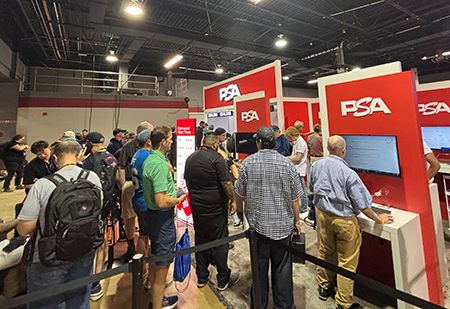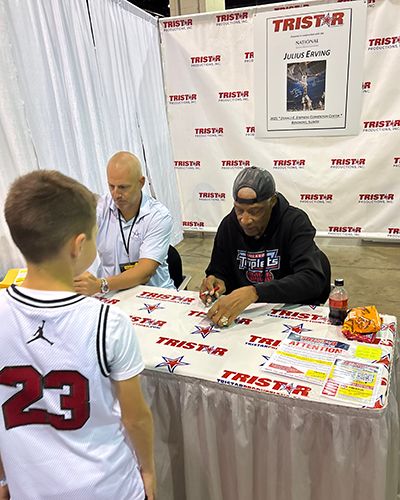ROSEMONT, Illinois — The 2025 National Sports Collectors Convention is a wrap, and cllct spent all five days on the ground taking in all the show had to offer.
From the good and the bad to the awkward, here are 10 key things the cllct team took away from the 45th annual National.
1. Still a force
The rise and improvement of Fanatics Fest over the last two years have been impressive.
The event has become an instant hit — roughly 125,000 attended Fanatics' three-day festival earlier this summer in New York — and it’s clear the show is a great way to get the younger generation interested in the hobby.
The National remains the industry’s premier sports card show, however, and the massive interest this week solidified that status. General admission lines were shockingly long Thursday, Friday and Saturday and trade nights, which we’ll cover soon, were as popular as ever.
Both shows have their own spirit, and after this run in Chicago, it’s clear that not only can both coexist, there might be room for additional shows at this scale.
Fanatics Fest has caused some collectors to question whether an old-school show such as the National could be heading toward a painful death, but evidence from Chicago points toward the contrary.
RELATED STORIES:
- The National 2025: Scenes from the show in Chicago
- Detroit to host 2028 National Sports Collectors Convention
2. PSA remains king
Lines to get cards graded with PSA were long for the entire show in Chicago, again showing the company’s dominance in the space.

According to PSA, roughly 10,000 cards and tickets were submitted for on-site grading by early Sunday for an increase of 30% year-over-year. The PSA Vault saw a more than 400% increase in submissions by Sunday than it did in 2024. Those items are estimated to have a value of about $18 million.
Post-show grading was also massive with almost 60,000 items submitted as of early Sunday. That total is up 70% from 2024.
3. Thriving dealers
Many vendors who spoke with cllct throughout the show reported extremely positive results.
Just Collect’s Leighton Sheldon reported buying a near-complete T206 set that he expected to be a tough but worthwhile flip.
It sold Saturday afternoon.
“We thought it was a long shot we could sell it,” Sheldon told cllct. “We probably could have sold two or three sets.”
Even entertainment items sold well, with Memory Lane’s Dan Wulkan reporting the company sold 45 autographed Taylor Swift collectibles despite the songwriter’s reputation as a generous signer.
“I’ve been transparent that she’s signed thousands and thousands," Wulkan told cllct. “They still love them.”
Despite their ability to easily move inventory, some dealers expressed concern the current market is too good to be true. Unlike the last trading card boom, which arrived alongside the COVID-19 pandemic, the driver of the current run-up is far less clear.
The industry’s growing reliance on repacks and mystery boxes has helped drive secondary-market prices, but that could be the next bubble to pop. Repacks and mystery boxes were as prevalent as ever in Chicago, and it’s hard to see the trend slowing down when even high-end auction houses such as Sotheby’s are entering the space.
4. Oddball pavilion
Breaking remains one of the most popular businesses in the hobby and some of the biggest faces in the space have even become quasi-celebrites when roaming card shows.
The breakers pavilion at the National is big, and it’s loud, but it also feels a little out of place. The area is distinctive from the rest of the show, but that’s not necessarily a good thing.
Some collectors have been captivated by seeing the process close-up, but many who cllct spoke with felt the area seemed odd and didn’t match the rest of the show. Sure, sports fans will line up and wait for hours to see College GameDay in person, but the breaking industry simply hasn’t reached that level of fandom yet.
For now, it seems like an area that many collectors attempted to avoid rather than interact with.
5. More space needed
The Donald E. Stephens Convention Center utilized more space than ever for this year’s show, but it still seemed too packed on the first floor.
No, the National hasn’t outgrown the city of Chicago yet — it has almost certainly outgrown last year’s venue in Cleveland — but it’s clear the venue will need to stretch its available space even further in 2026 and beyond.
The second floor of the convention center, which housed first-time dealers and a large area dedicated to private memorabilia signings through Tristar, had a significant amount of unused space that could have been used.
The area for first-time dealers was far too small and a significant portion of space opposite that area was left empty.
More space will be needed moving forward, but the venue in Rosemont should be able to comfortably expand if planned property.
6. Better food
Food options were greatly improved last year in Cleveland, with a number of choices available on the show floor. Those options were largely greasy and unhealthy with long lines, however.
The number of offerings in Chicago was smaller but higher in quality. Lines were also managed better than in Cleveland, making it easier to eat without leaving the convention center.
A dedicated space for food, similar to last year’s convention in Cleveland, would be nice, as long as Chicago continues to offer healthier options and improved wait times.
The venue’s second floor, with so much unused space, could be a good place to position a dozen or so food trucks away from the cards and collectibles.
7. TCG letdown
Some collectors balked when a map of the venue showed 50 of the more than 600 dealers planned to have TCG and non-sports cards of some kind.
That number seemed large, but it wasn’t felt on the show floor in a tangible way.
The National Sports Collectors Convention is still dominated by sports cards, and any fear that the TCG community would take over the hobby’s biggest show can be put on hold for another year.
Truthfully, the show could have had a little more variety than it did without feeling unbalanced.
8. Awkward ink

The autograph pavilion remains one of the biggest draws, but it still feels too chaotic, especially for newcomers.
No, the process isn’t terribly complicated, but it can feel overwhelming upon entrance.
The queues for each athlete are clearly marked and easy to understand, but autograph hunters pooling toward the front of the queue entrance before their turn obstructs the view of the area and causes confusion.
Streamlining the process with more clear signage and a more organized crowd could greatly improve the process — something that could be desperately needed fast.
Recent autograph scandals have shaken the community, and it’s more important than ever for some to secure their ink directly from the athletes rather than a third party.
If collectors aren’t willing to buy autographs authenticated by third parties, events such as the National will become even more critical.
9. Trade nights are red-hot
Organized trade nights were bigger than ever. Unorganized events at hotels and restaurants were bigger than ever, too.
The passion and interest for these types of events is strong, and the National did a good job keeping collectors on-site with dedicated rooms Thursday, Friday and Saturday. Plus, there were numerous events at surrounding hotels.
Trade nights have become so popular, in fact, that the National might have run into a good problem to have. The dedicated spaces were considered a little too small, resulting in long lines after collectors already had long days.
The trade events themselves have become nearly as popular as the show itself, and the next step for organizers likely includes finding a solution for the scope. More themed events could help break up the cumbersome crowds and possibly get even more collectors involved.
The key will be keeping the events unique in spirit to the show itself.
10. Vendor growth
It was great to see the National add dedicated space for vendors selling for the first time — the waitlist to attend the show as a dealer is long and has been a frustrating experience for many.
Letting new sellers in will be key for the show moving forward, and it will likely help improve the overall experience with more variety.
Though the event added new vendors, it still suffers some from dealers who have attended for decades but add little value to the show. They know who they are and show up year after year with poor inventory, bad attitudes and even worse pricing.
It’s hard to call for these vendors to be ejected from the event, but it’s also hard to ignore when a not insignificant number of sellers don’t have much interest in selling anything.
The second-floor space dedicated to new sellers was a critical step taken by organizers to usher in the next generation of sellers and the National should consider pushing the concept even further in 2026.
Ben Burrows is a reporter and editor for cllct, the premier company for collectible culture. He was previously the Collectibles Editor at Sports Illustrated. You can follow him on X and Instagram @benmburrows.
Darren Rovell is the founder of cllct and one of the country's leading reporters on the collectibles market. He previously worked for ESPN, CNBC and The Action Network.

